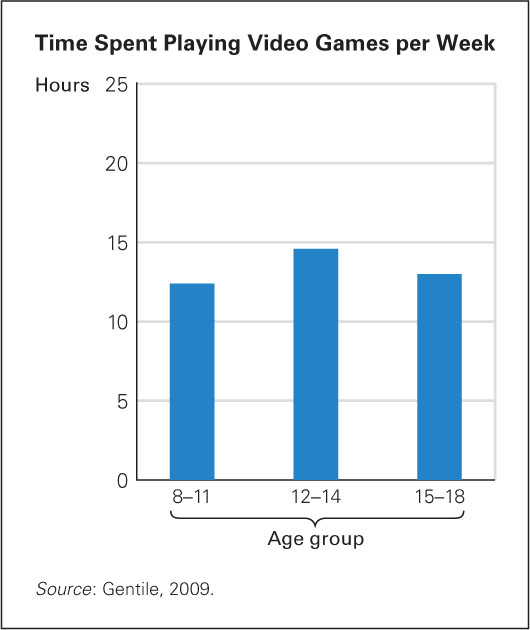 Digital Natives
Digital Natives
Adults over age 40 grew up without the Internet, instant messaging, Twitter, Snapchat, blogs, cell phones, smart phones, MP3 players, tablets, or digital cameras. Until 2006, only students at elite colleges could join Facebook. In contrast, today’s teenagers are “digital natives.” Since childhood they have been networking, texting, and clicking for definitions, directions, and data. Most adolescents have mobile devices within reach, day and night.
The gap between those with and without computers was bemoaned a decade ago; it divided boys from girls and rich from poor (Dijk, 2005; Norris, 2001). However, within nations, that digital divide is shrinking, though digital differences remain. Low-
However, the arrival of lower-
Today’s adolescents and emerging adults take technology for granted. Most own computers; some own companies. The most notable digital divide is now age: In 2011, 95 percent of teenagers were online compared to only 41 percent of those over the age of 65 (Zickuhr and Smith, April 13, 2012). [Lifespan Link: Use of technology in late adulthood is discussed in Chapter 25.] No wonder most critics of technology are older adults.
Observation Quiz Is teenage conformity more evident in the photo in Shanghai (right) or in Texas (left)?
Answer to Observation Quiz: Probably in Texas…but do both Chinese teens really like the same flavor and size of ice cream cone? The Texas trio all wear faded blue jeans, short-

© JEFF GREENBERG/ALAMY
Technology and Cognition
In general, educators accept, even welcome, digital natives. In many high schools, teachers use laptops, smartphones, and so on as tools for learning. In some districts, students are required to take at least one class completely online. There are “virtual” schools, in which students earn all their credits online, never entering a school building.
Recall that research conducted before the technology explosion found that education, conversation, and experience advance adolescent thought. Social networking via technology may speed up this process, as teens communicate daily with dozens—
Most secondary students check facts, read explanations, view videos, and thus grasp concepts they would not have understood without technology. For some adolescents, the Internet is their only source of information about health and sex. Students use the Internet for research, finding it quicker and more extensive than books on library shelves.
Teachers use it, too, not only for research and assignments, but also to judge whether or not a student’s paper is plagiarized. Educators claim that the most difficult aspect of technology is teaching students how to evaluate sources, some reputable, some nonsensical. To this end, teachers explain the significance of .com, .org, .edu, and .gov (O’Hanlon, 2013).
A New Addiction?
Parents worry about sexual abuse via the Internet. There is reassuring research here: Although sexual predators lurk online, most teens avoid them, just as most adults avoid distasteful ads and pornography. Sexual abuse is a serious problem, but social networking does not increase the risk (Wolak et al., 2008).

FIGURE 15.5
More Than Eating The average adolescent boy spends more time playing video games than reading, eating, doing homework, talking with friends, playing sports, or almost anything else except sleeping or sitting in class. Indeed, some skip school or postpone sleep to finish a game.Technology does present some dangers, however. It encourages rapid shifts of attention, multitasking without reflection, and visual learning instead of invisible analysis (Greenfield, 2009). Video games with violent content promote aggression (Gentile, 2011). For some adolescents, chat rooms, video games, and Internet gambling are addictive, taking time from needed play, schoolwork, and friendship.
This is not mere speculation. A study of almost two thousand older children and adolescents in the United States found that the average person played video games two hours a day. Some played much more, and only 3 percent of the boys and 21 percent of the girls never played (Gentile, 2011) (see Figure 15.5). Another survey found that almost one-
Many adolescents in the first survey admit that video game playing takes time away from household chores and homework. Worse, one-
Using criteria for addiction developed by psychiatrists for other addictions (gambling, drugs, and so on), one study found that 12 percent of the boys and 3 percent of the girls were addicted to playing video games. Remember that correlation is not causation, so perhaps low school achievement led to video game playing rather than vice versa. However, another study began with younger boys whose parents intended to buy them a video game system. Randomly, half of them were given the system, and the other half had to wait four months. Those who received the video game system had lower reading and writing achievement after 4 months than did their peers who waited (Weis & Cerankosky, 2010).
Most screen time occurs at home, often in the child’s own bedroom. About half of all parents do not impose restrictions on what kind of technology their adolescents use, when they use it, or for how long at a sitting. Some suggest that technology should be banned from schools and bedrooms, but, as one critic writes, “we don’t ban pencils and paper because students pass notes” (Shuler, 2009, p. 35). Some teachers confiscate computers and cell phones used in class, others ignore them, and still others include them in the curriculum.
Whether extensive use of the Internet qualifies as an addiction is controversial. The psychiatrists who wrote the new DSM 5, after consideration, did not include it as an addiction. On the other hand, authors of studies in many nations found that a sizable minority of high school students (e.g., Turkey, 15 percent, and India, 12 percent) were addicted to computer use (Şaşmaz et al., 2014; Yadav et al., 2013). Whether a psychological disorder or not, overuse of technology is problematic for some adolescents.
Cyber Danger
cyberbullying Bullying that occurs when one person spreads insults or rumors about another by means of emails, text messages, or cell phone videos.
When a person is bullied via electronic devices, usually via e-
Worst in Adolescence
Texted and emailed rumors and insults can “go viral,” reaching thousands, transmitted day and night. The imaginary audience magnifies the shame (Englander et al., 2009). Not only words but also photos can be easily sent: Some adolescents photograph others drunk, naked, or crying and send the photo to dozens of others, who may send it to yet others. Since adolescents are quick-

While the causes of all forms of bullying are similar, each form has its own sting: cyberbullying may be worst when the imaginary audience is strong, the identity is forming, and impulsive thoughts precede analytic ones. Adolescent victims are likely to suffer from depression and may commit suicide (Bonannor & Hymel, 2013).
The school climate affects all forms of bullying. When students consider their school a good place to be—
A complication is that most adolescents trust technology while many adults ignore it. Parents and teachers are often unaware of cyberbullying, and few laws and policies successfully prevent it. Some school administrators insist that, since cyberbullying does not emanate from school computers, they cannot stop it. However, cyberbullying usually occurs among classmates and can poison the school climate, and thus educators must be concerned. Adolescents are vulnerable, needing more protection than adults realize.
Sexting
The vulnerability of adolescence was tragically evident in the suicide of a California 15-
One aspect of this tragedy will come as no surprise to adolescents: “sexting,” as sending sexual photographs is called. Willingly or not, almost 3 percent of a national sample of 10-
Other studies report as many as 30 percent of adolescents report having received sexting photos, although variation by school, gender, and ethnicity is evident (Temple et al., 2014). Adults are seldom aware of this activity, which technically is child pornography.
Every study finds that sexting has two dangers; (1) the pictures are often forwarded without the naked person’s knowledge, and (2) senders risk serious depression if the reaction is not what they wished (Temple et al., 2014). Remember that body image formation is crucial during early adolescence, and that many teens have distorted self-
The other destructive side of Internet connections is that it allows adolescents to connect with others who share their prejudices and self-
The danger of all forms of technology lies not in the equipment but in the cognition of the user. As is true of many aspects of adolescence (puberty, brain development, egocentric thought, contraception, and so on), context, adults, peers, and the adolescent’s own personality and temperament “shape, mediate, and/or modify effects” of technology (Oakes, 2009, p. 1142).
Teens are intuitive, impulsive, and egocentric, and they often have difficulty analyzing the impact of whatever they send or limiting the power of whatever they read. Adults should know better, but all of us are sometimes illogical and emotional: It takes time and experience to use technology wisely.
SUMMING UP
In fostering adolescent cognition, technology has many positive aspects: A computer is a tool for learning, and online connections promote social outreach and reduce isolation, especially for those who feel marginalized. Friends often connect via texting and email, and social-